How to Use Anchor Text to Improve Your SEO Ranking
What Is an Anchor Text?
Anchor text refers to the clickable, hyperlinked text that serves as a navigational signpost for both search engine crawlers and users to reach the linked destination. Effective anchor text is relevant to the linked page’s content, offering a brief summary or a hint about the information it leads to.
Why is Anchor Text Important for SEO?
Text Links are crucial for SEO. Including links in the content can help search engines understand the structure of your website. The text within the link makes it easier for search engines to understand internal links; it provides the search engines with more context. When you link to other content, Google uses the link text to understand the content of the linked page, as an indicator of the topic. If the link text matches your keyphrase, Google may have difficulty determining which article is more relevant for the topic and should rank for that keyphrase. So yes, using anchor text strategically is crucial for SEO.
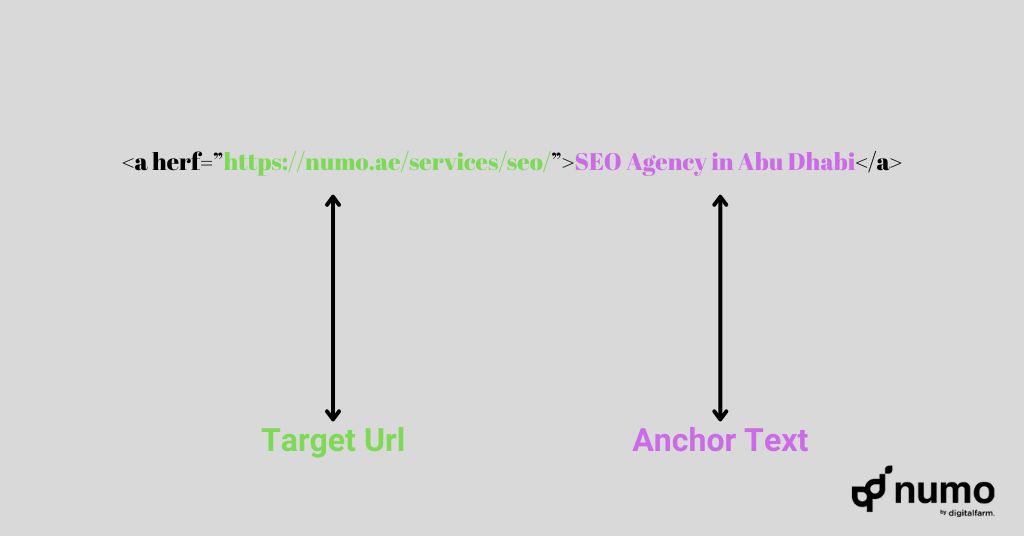
The Google Penguin Update
Before Google penguin update 2012, people used exact match anchor texts on their backlinks and it worked well. After the Google penguin update in 2012. Many websites were affected due to this and dropped rankings, Over optimized anchor texts still do badly affect SEO.
How to Choose the Right Anchor Text
Before we delve into how to best choose the right anchor text for SEO strategy. We need to understand what kinds of anchor text exist and how we can use those in our content.
Make Sure Anchor Text are Relevant
Relevant anchor text aids Google in deciphering the architecture of your website. So it might raise the ranking of your website. Using pertinent anchor language makes it appear more natural to your readers. This is so that Google and other online users may determine the purpose of web sites by reading the anchor text. Consider what would result in the most natural experience when choosing your words.
Use descriptive and engaging anchor text
Descriptive, and engaging anchor text is effective. Create content that offers a brief synopsis or an enticing teaser of what the linked page has to offer. Engage readers by their interest and provide a sneak peek of the insightful details and answers they will discover when clicking the link.
Review Link Relevancy
A search engine ranking element called link relevance assesses how similar two pages’ content is when one connects to another. Google makes this determination based on the topic of the source page. Information in the source page’s anchor text. Links that are relevant can improve both pages’ rankings. Make your anchor text as descriptive of the target page as you can to assist your links. Give the search engines strong relevancy signals.
Use Word Variety
Repetitive use of the same anchor text might lead Google bots and crawlers to suspect keyword stuffing.
So, how do you navigate this challenge when linking to similar content? The solution lies in utilizing keyword variations LSI keywords. For eg:, if targeting “Digital marketing in Abu Dhabi,”. you can create variations such as “Social media Marketing,” or “SEO agency in Abu Dhabi.” These phrases convey the same meaning and are akin to your target keyword. This approach is also valuable for integrating your keyword into a sentence. Don’t hesitate to add extra words or tweak keywords to ensure they harmonize within your text.
Reasonable anchor text
Take into account how easy it is for readers to understand your content.
Avoid using words that are too general or ambiguous to convey accurate information. Instead, use anchor language that makes sense within the context of the sentence or paragraph, also simple to understand. Putting readability first, you motivate visitors to click on your links and explore more of your website.
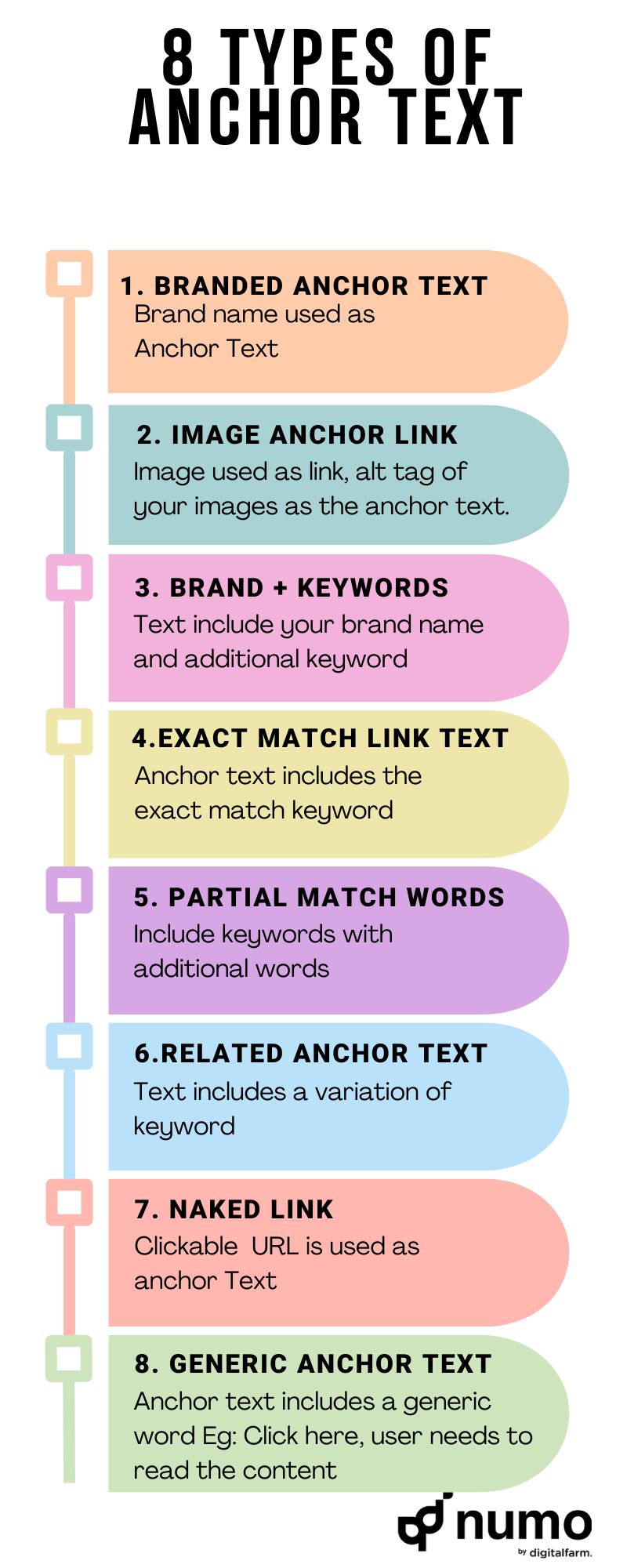
Mueller apparently intuited that in the question and correctly advised the publisher to use a “reasonable anchor text” and encouraged the publisher to do what “makes sense for your users” which is good advice.
Keep in Mind Internal First Link Priority
When you are considering two pages in that If your Page 1 on your site links to Page 2 on your site two times. Google only considers the anchor text of the first link in ranking Page 2.Therefore, you need to ensure that as anchor text in the first link that appears from Page 1 to Page 2. If you want a specific page on your website to rank high.
Do you want to apply the best internal linking strategy to drive more traffic and visibility? Grow with the best Digital Marketing Agency Abu Dhabi.
How to place Anchor Text in your Content
The content of anchor text on that source page
Search engines analyze the various anchor text variations used to link back to the original article. These variations serve as more cues, indicating the content of the article and its relevance to specific search queries. This, coupled with natural language processing and factors such as the source of the link and information hierarchy, constitutes the majority of indicators for link relevancy online. To ensure that your links convey relevance, it’s essential to use descriptive anchor text that represents the content of the target page.
Links that direct users to content relevant to the topic of the source page are more likely to convey significant relevance signals compared to links leading to unrelated material. For instance,
Anchor text keyword density
With the introduction of the Penguin algorithm update, Google started paying greater attention to keywords used in anchor text. If a website has too many inbound links. Identical anchor text, it might raise suspicions, suggesting that the links were not obtained . While it remains advisable to use anchor text relevant to keywords and topics. SEO practitioners could achieve more favorable outcomes by diversifying their anchor text with natural phrases. Rather than relying solely on repetitive keywords.
Be Mindful of the Text Around Your Links
The content encircling your anchor text plays a crucial role in enhancing readers’ comprehension of the linked content. Additionally, it provides valuable context to search engines. Modern search algorithms, especially Google’s, rank natural language to deliver precise results. In alignment with users’ authentic queries and speech patterns. Thus, you must be mindful of the language used in proximity to your anchor text.
Consider a scenario where you come across a hyperlink while perusing content. Your decision to click on the link isn’t solely based on the anchor text itself. Chances are, you’ll read the entire sentence or even the entire paragraph containing the anchor text before deciding to “Click here”.
Match anchor text with the linked content
Align the anchor text with the content it links to, ensuring it accurately reflects the topic or theme of the destination page. This alignment helps search engines comprehend context and establishes clear expectations. Users, enhancing their browsing experience.
Incorporate keywords strategically in Content
Integrate keywords thoughtfully by identifying pertinent terms associated with the linked page and embedding them into your anchor text. Be mindful to steer clear of excessive optimization or stuffing keywords, as these practices can harm your search engine rankings. Instead of forcibly inserting anchor text, let it naturally emerge within the narrative. This method not only meets user expectations but also assists search engines in understanding the context and significance of your content.
Practice Link Type Distribution
Incorporating various types of visual anchor links in your content is crucial, as discussed earlier. To create a seamless experience for your readers and optimize your links, it’s advisable to blend different link types when connecting to both internal and external content. While there’s no fixed ratio for their usage.
Choosing the consistency in variations in anchor text is important in internal linking strategy. Achieve a harmonious blend of diversity and uniformity in your anchor text and internal linking approach. Aim for a versatile anchor text profile that blends diverse phrases and variations to create a natural linking structure. Simultaneously, ensure consistency within specific content themes or categories to bolster topical relevance and position your website as an authoritative source in those fields.
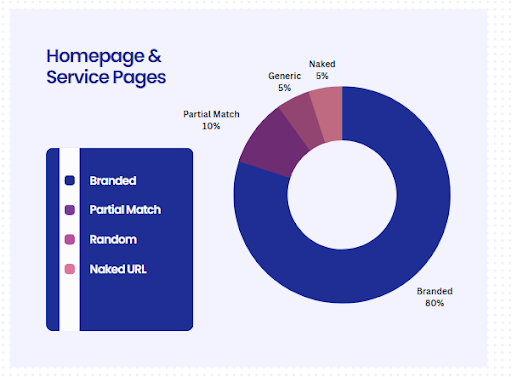
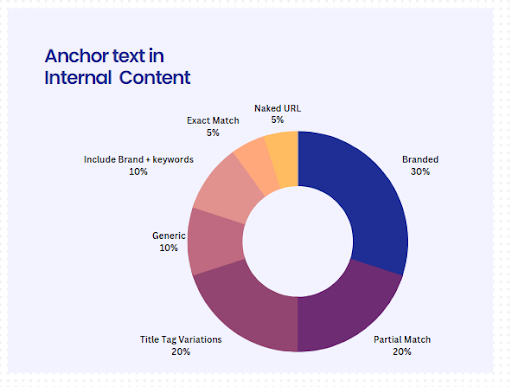
Monitor Your Internal Links
Internal linking is a fundamental SEO strategy, but it’s crucial to be mindful of the anchor text used when linking to your own pages. Just as you wouldn’t want numerous external sources to employ identical anchor text for linking to your content, avoid this practice internally as well. Ensure that multiple links leading to the same pages on your site don’t use precisely the same wording for anchor text.
Examine Your Competition
While it’s crucial to incorporate various anchor text types into your website or content, what constitutes a “natural” distribution can vary based on industry or specific keywords. To gain insights, explore the backlink profiles of leading competitors in your niche and those targeting the same keywords. Analyze how others are linking to them and discern the search engines’ perspective on natural distribution for these high-ranking pages.Tools like Ahrefs can assist you in this process. These applications analyze referring domains and the anchor text used in the links.
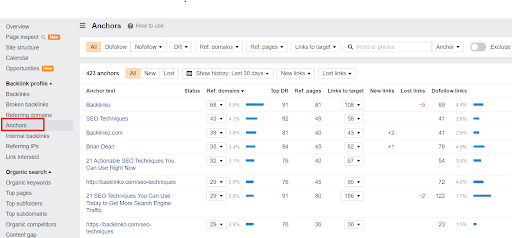
How to build backlinks with anchor text.
Relevancy is just as important as anchor text in backlinks
You must take into account every aspect of backlink building if you want to truly create content. This won’t work if your only goal is to improve your rank by changing the anchor text in your backlinks. The two pages’ relevance to one another can possibly be more crucial than the anchor text used.
Avoid exact keyword matches
Using exact keyword matches in backlinks from guest post bios and blog comments. While exact match anchor text within the content of a guest post can enhance SEO, Google scrutinizes these backlinks closely.
Check your backlink profile frequently
You have to check all your links and identify any potential issues. You’ll have the ability to review the specific anchor text utilized in each backlink and assess its impact on your ranking.
Make sure your backlink need anchor text
Ensure the diversity of your backlink anchor text for a natural backlink profile. Utilizing various types of anchor text based on specific situations is the best approach. A varied backlink profile appears more organic. Enhancing your website’s authenticity and reducing the risk of penalties.
Conclusion
Understanding how to use anchor text effectively is important for enhancing your SEO rankings. By crafting relevant, descriptive, and natural anchor text, you can enhance user experience. This will provide search engines with valuable context about your content. Boosts website visibility and credibility through choosing the right anchor text, that will improve website rankings in search engine results pages.

